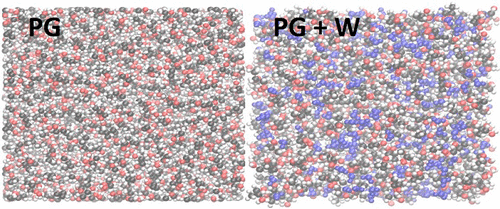当前位置:
X-MOL 学术
›
J. Phys. Chem. B
›
论文详情
Our official English website, www.x-mol.net, welcomes your
feedback! (Note: you will need to create a separate account there.)
New Force Field Model for Propylene Glycol: Insight to Local Structure and Dynamics
The Journal of Physical Chemistry B ( IF 2.8 ) Pub Date : 2017-11-21 00:00:00 , DOI: 10.1021/acs.jpcb.7b08251 Elisabete S. C. Ferreira 1, 2 , Iuliia V. Voroshylova 1, 2 , Volodymyr A. Koverga 3, 4 , Carlos M. Pereira 2 , M. Natália D. S. Cordeiro 1
The Journal of Physical Chemistry B ( IF 2.8 ) Pub Date : 2017-11-21 00:00:00 , DOI: 10.1021/acs.jpcb.7b08251 Elisabete S. C. Ferreira 1, 2 , Iuliia V. Voroshylova 1, 2 , Volodymyr A. Koverga 3, 4 , Carlos M. Pereira 2 , M. Natália D. S. Cordeiro 1
Affiliation

|
In this work we developed a new force field model (FFM) for propylene glycol (PG) based on the OPLS all-atom potential. The OPLS potential was refined using quantum chemical calculations, taking into account the densities and self-diffusion coefficients. The validation of this new FFM was carried out based on a wide range of physicochemical properties, such as density, enthalpy of vaporization, self-diffusion coefficients, isothermal compressibility, surface tension, and shear viscosity. The molecular dynamics (MD) simulations were performed over a large range of temperatures (293.15–373.15 K). The comparison with other force field models, such as OPLS, CHARMM27, and GAFF, revealed a large improvement of the results, allowing a better agreement with experimental data. Specific structural properties (radial distribution functions, hydrogen bonding and spatial distribution functions) were then analyzed in order to support the adequacy of the proposed FFM. Pure propylene glycol forms a continuous phase, displaying no microstructures. It is shown that the developed FFM gives rise to suitable results not only for pure propylene glycol but also for mixtures by testing its behavior for a 50 mol % aqueous propylene glycol solution. Furthermore, it is demonstrated that the addition of water to the PG phase produces a homogeneous solution and that the hydration interactions prevail over the propylene glycol self-association interactions.
中文翻译:

丙二醇的新力场模型:对局部结构和动力学的认识
在这项工作中,我们基于OPLS的全原子电势开发了用于丙二醇(PG)的新力场模型(FFM)。考虑到密度和自扩散系数,使用量子化学计算精炼了OPLS势。这种新的FFM的验证是基于广泛的理化特性,例如密度,汽化焓,自扩散系数,等温压缩性,表面张力和剪切粘度。分子动力学(MD)模拟是在很大的温度范围(293.15–373.15 K)下进行的。与其他力场模型(例如OPLS,CHARMM27和GAFF)的比较显示,结果有了很大的改进,从而与实验数据更加吻合。特定的结构特性(径向分布函数,然后分析氢键和空间分布函数,以支持所提出的FFM的充分性。纯丙二醇形成连续相,没有任何微观结构。结果表明,通过测试其在50摩尔%丙二醇水溶液中的行为,开发出的FFM不仅可对纯丙二醇产生适当的结果,而且对于混合物也可产生适当的结果。此外,已证明向PG相中添加水产生均匀溶液,并且水合相互作用胜过丙二醇自缔合相互作用。结果表明,通过测试其在50摩尔%丙二醇水溶液中的行为,开发出的FFM不仅可对纯丙二醇产生适当的结果,而且对于混合物也可产生适当的结果。此外,已证明向PG相中添加水产生均匀溶液,并且水合相互作用胜过丙二醇自缔合相互作用。结果表明,通过测试其在50摩尔%丙二醇水溶液中的行为,开发出的FFM不仅可对纯丙二醇产生适当的结果,而且对于混合物也可产生适当的结果。此外,已证明向PG相中添加水产生均匀溶液,并且水合相互作用胜过丙二醇自缔合相互作用。
更新日期:2017-11-21
中文翻译:

丙二醇的新力场模型:对局部结构和动力学的认识
在这项工作中,我们基于OPLS的全原子电势开发了用于丙二醇(PG)的新力场模型(FFM)。考虑到密度和自扩散系数,使用量子化学计算精炼了OPLS势。这种新的FFM的验证是基于广泛的理化特性,例如密度,汽化焓,自扩散系数,等温压缩性,表面张力和剪切粘度。分子动力学(MD)模拟是在很大的温度范围(293.15–373.15 K)下进行的。与其他力场模型(例如OPLS,CHARMM27和GAFF)的比较显示,结果有了很大的改进,从而与实验数据更加吻合。特定的结构特性(径向分布函数,然后分析氢键和空间分布函数,以支持所提出的FFM的充分性。纯丙二醇形成连续相,没有任何微观结构。结果表明,通过测试其在50摩尔%丙二醇水溶液中的行为,开发出的FFM不仅可对纯丙二醇产生适当的结果,而且对于混合物也可产生适当的结果。此外,已证明向PG相中添加水产生均匀溶液,并且水合相互作用胜过丙二醇自缔合相互作用。结果表明,通过测试其在50摩尔%丙二醇水溶液中的行为,开发出的FFM不仅可对纯丙二醇产生适当的结果,而且对于混合物也可产生适当的结果。此外,已证明向PG相中添加水产生均匀溶液,并且水合相互作用胜过丙二醇自缔合相互作用。结果表明,通过测试其在50摩尔%丙二醇水溶液中的行为,开发出的FFM不仅可对纯丙二醇产生适当的结果,而且对于混合物也可产生适当的结果。此外,已证明向PG相中添加水产生均匀溶液,并且水合相互作用胜过丙二醇自缔合相互作用。







































 京公网安备 11010802027423号
京公网安备 11010802027423号